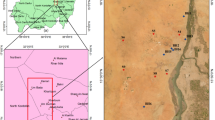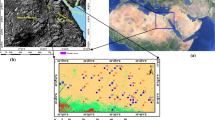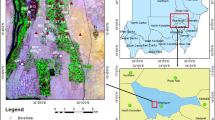Abstract
This study was carried out in the Adamawa region, which connects Cameroon, Central African Republic, and Nigeria together. The main objective of this work is to assess the geophysical aspects of the local Pan-African hydraulic conductivity (K), using the vertical electrical sounding technique (VES) as an alternative approach to pumping test. This economical, less-time consuming, and easy-to-process alternative technique provides more accurate hydraulic conductivity values than the traditional pumping test technique. The K values obtained by the VES technique (ranging between 0.4 and 6.0 m/day) match those obtained by the pumping tests results. A thorough analysis of the transmissivity values reveals the existence of two aquifer trends in the region: Trend-1 with transmissivity values ranging from 34.22 to 39.27 m2/day with an average value of 35.44, and Trend-2, with transmissivity values of 7.87–34.44 m2/day with an average value of 16.56. Maps of transmissivity (T), resistivity (ρ), thickness (h), transverse resistance (TR), and hydraulic conductivity (K) of the Pan-African aquifer, derived from quantitative VES data interpretation, are established. These parameters are of paramount importance to the management of groundwater resources. They are important in the sense that geological contexts similar to that of Pan-African aquifer cut across Africa and South America. Therefore, this article will be valuable to regions worldwide that are geologically similar to the Adamawa Region.









Similar content being viewed by others
References
Allan, J. A. (1998). Virtual water: A strategic resource. Ground Water, 36, 545–546. https://doi.org/10.1111/j.1745-6584.1998.tb02825.x.
Arétouyap, Z., Njandjock Nouck, P., Bisso, D., Nouayou, R., Lengué, B., & Lepatio Tchieg, A. (2014). Climate variability and its possible interactions with water resources in Central Africa. Journal of Applied Sciences, 14(19), 2219–2233.
Arétouyap, Z., Nouayou, R., Njandjock Nouck, P., & Asfahani, J. (2015). Aquifers productivity in the Pan-African context. Journal of Earth System Science, 124(3), 527–539.
Asfahani, J. (2007a). Geoelectrical investigation for characterizing the hydrogeological conditions in semi-arid region in Khanasser valley, Syria. Journal of Arid Environments, 68(1), 31–52.
Asfahani, J. (2007b). Neogene aquifer properties specified through the interpretation of electrical sounding data. Sallamiyeh region, central Syria. Hydrological Processes, 21(21), 2934–2943.
Asfahani, J. (2012). Quaternary aquifer transmissivity derived from vertical electrical sounding measurements in the semi-arid Khanasser valley region, Syria. Acta Geophysica, 60(4), 1143–1158.
Asfahani, J. (2013). Groundwater potential estimation deduced from vertical electrical sounding measurements in the semi-arid Khanasser Valley region, Syria. Hydrology Sciences Journal, 58, 468–482.
Bachelier, G., & Laplante, C. (1953). Un processus pédogénétique de formation des cuirasses dites latéritiques dans l’Adamaoua. Paris: ORSTOM.
Cornacchia, M., & Dars, R. (1983). Un trait structural majeur du continent africain. Les linéaments centrafricains du Cameroun au Golfe d’Aden. Bulletin de la Société géologique de France, 7, 101–109.
Dey, H., & Morrison, H. (1979). Resistivity modeling for arbitrarily shaped 3-D structures. Geophysics, 44(4), 753.
Djeuda Tchapnga, H. B. (1988). Géologie et hydrogéologie d’un secteur de la zone mobile d’Afrique centrale: région de poli (Nord-Cameroun). Dissertation, University of Grenoble I, 304p.
Dumont, J. F. (1986). Identification par télédétection de l’accident de la Sanaga (Cameroun). Sa position dans le contexte des grands accidents d’Afrique centrale et de la limite nord du craton congolais. Géodynamique, 1, 13–19.
Maillet, R. (1947). The fundamental equations of electrical prospecting. Geophysics, 12, 529–556.
Maréchal, A. (1976). Géologie et géochimie des ressources thermominérales du Cameroun. Doc ORSTOM, 59, 169–176.
Mazáč, O., & Landa, I. (1979). On determination of hydraulic conductivity and transmissivity of granular aquifers by vertical electric sounding. Journal of Geological Sciences, 16, 123–139.
Ngako, V., Jegouzo, P., & Nzenti, J. P. (1991). Le Cisaillement Centre Camerounais. Rôle structural de la zone mobile panafricaine de l’Afrique Centrale au contact du craton du Congo. CR Academy Science II, 303(2), 369–381.
Nguetnkam, J. P., Kamga, R., Villieras, F., Ekodeck, G. E., & Yvon, J. (2002). Typologie des argiles des vertisols et des sols fersialitiques du Nord Cameroun. Communication presented to French Group of Clays (GFA), Paris, Nov. 2002 (pp. 17–28).
Njonfang, E., Ngako, V., Moreau, C., Affaton, P., & Diot, H. (2008). Restraining bends in high temperature shear zones: “The Central Cameroon Shear Zone”, Central Africa. Journal of African Earth Sciences, 52, 9–20.
Orellana, E., & Mooney, H. M. (1966). Master Tables and curves for vertical electrical sounding over layered structures. Madrid: Interciencia.
Robain, H., Descloitres, M., Ritz, M., & Yene Atangana, J. Q. (1996). A multiscale electrical survery of a lateritic soil system of the rain forest of Cameroon. Journal of Applied Geophysics, 47, 237–253.
Srinivasan, V., Konar, M., & Sivapalan, M. (2017). A dynamic framework for water security. Water Security, 1, 12–20.
Tchameni, R., Mezger, R., Nsifa, N. E., & Pouclet, A. (2001). Crustal Origin of Early Proterozoïc Syenites in the Congo. Ntem Complex, South Cameroon. Lithos 57.
Tillement, B. (1972). Hydrogéologie du Nord Cameroun: Ph.D. thesis, University of Lyon.
Toteu, S. F., Ngako, V., Affaton, P., Nnange, J. M., & Njanko, T. H. (2000). Pan-African tectonic evolution in Central and Southern Cameroon: Tranpression and transtension during sinistral shear movements. Journal of African Earth Sciences, 36, 207–214.
Toteu, S. F., Penaye, J., & Poudjom Djomani, Y. (2004). Geodynamic evolution of the Pan-African belt in central Africa with special reference to Cameroon. Canadian Journal of Earth Sciences, 41, 73–85.
Vincent, P. M. (1970). Conséquences tectoniques de la présence d’un métamorphisme crétacé au Cameroun (pp. 431–434). Cameroun: Annuaire Faculté des Sciences, Université de Yaoundé.
Vogel, R. M. (2017). Stochastic watershed models for hydrologic risk management. Water Security, 1, 28–35.
Zohdy, A. A. R. (1989). A new method for the automatic interpretation of Schlumberger and Wenner sounding curves. Geophysics, 54, 245–253.
Zohdy, A. A. R., & Bisdorf, R. J. (1989). Schlumberger sounding data processing and interpretation program. Washington: US Geological Survey.
Acknowledgments
We are thankful to both anonymous reviewers and to Prof. John Carranza, the Editor-in-Chief, for their comments and advice that helped us improve the quality of this paper, and to Prof. Ibrahim Othman, the General Director of the Syrian Atomic Energy Commission. The first author would like to thank Dr. Amos Mfomtapmgboui for proofreading, and Dr. Isaac Mbowou for his precious technical advice.
Author information
Authors and Affiliations
Corresponding author
Rights and permissions
About this article
Cite this article
Arétouyap, Z., Bisso, D., Njandjock Nouck, P. et al. Hydrogeophysical Characteristics of Pan-African Aquifer Specified Through an Alternative Approach Based on the Interpretation of Vertical Electrical Sounding Data in the Adamawa Region, Central Africa. Nat Resour Res 28, 63–77 (2019). https://doi.org/10.1007/s11053-018-9373-8
Received:
Accepted:
Published:
Issue Date:
DOI: https://doi.org/10.1007/s11053-018-9373-8




